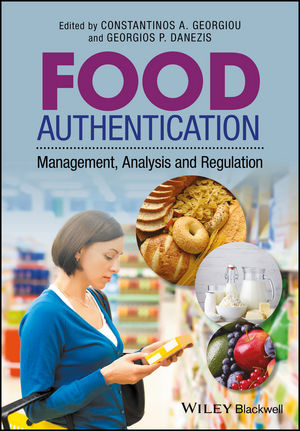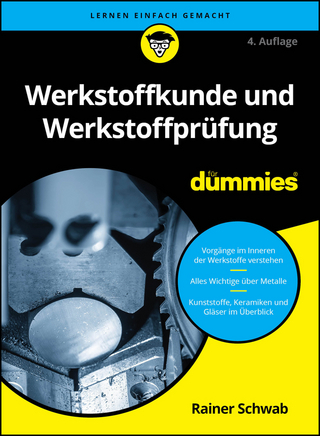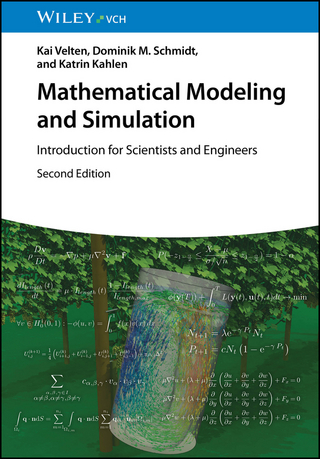
Food Authentication
Wiley-Blackwell (Verlag)
978-1-118-81026-2 (ISBN)
This book covers the most advanced techniques used for the authentication of a vast number of products around the world. The reader will be informed about the latest pertinent analytical techniques. Chapters focus on the novel techniques & markers that have emerged in recent years. An introductory section presents the concepts of food authentication while the second section examines in detail the analytical techniques for the detection of fraud relating to geographical, botanical, species and processing origin and production methods of food materials and ingredients. Finally, the third section looks at consumer attitudes towards food authenticity, the application of bioinformatics to this field, and the Editor’s conclusions and future outlook.
Beyond being a reference to researchers working in food authentication it will serve as an essential source to analytical scientists interested in the field and food scientists to appreciate analytical approaches. This book will be a companion to under- and postgraduate students in their wander in food authentication and aims to be useful to researchers in universities and research institutions.
Constantinos A. Georgiou, Agricultural University of Athens, Greece Georgios P. Danezis, Agricultural University of Athens, Greece
List of Contributors xv
Preface xix
Part A Introduction and Status 1
1 Introduction, Definitions and Legislation 3
Demetrios G. Sotirchos, Georgios P. Danezis and Constantinos A. Georgiou
1.1 Introduction 3
1.2 Definitions 4
1.2.1 Food Origin 4
1.2.2 Label 4
1.2.3 Adulteration and Fraud 4
1.3 Geographical Indications 5
1.3.1 PDO, PGI, and TSG 6
1.3.2 Wines 8
1.4 Organics 11
1.5 Conclusion 14
References 14
Legislation Acts 16
2 Food Authentication by Numbers 19
Georgios P. Danezis and Constantinos A. Georgiou
2.1 Introduction 19
2.2 Research Trends 19
2.3 Analytical Techniques 20
2.4 Countries 22
2.5 Journals 24
References 24
Part B Consumer Attitudes Towards Authentic Food and Market Analysis 25
3 The Concept of Authenticity and its Relevance to Consumers: Country and Place Branding in the Context of Food Authenticity 27
Athanasios Krystallis
3.1 Introduction: The Challenge of Authenticity 27
3.1.1 The Origin of Authenticity and its Marketing Relevance 27
3.1.2 The Philosophy of Authenticity 29
3.2 Countries as Brands: The Country-of-Origin (COO) Effect on Product Choices 30
3.2.1 Do Places get the Reputation they Deserve? 30
3.2.2 Countries as Brands 31
3.2.3 Impact of Country Names on Attitudes Towards Products 33
3.3 Place Branding: Geographic Indication Labels and their Effect on Food Choice 42
3.3.1 Mediterranean Diet: A Typical Place Marketing Paradigm 42
3.3.2 Regulatory Initiatives of Place Branding: Designation of Origin Labelled (DOL) Food and the PDO/PGI/TSG Schemes 50
3.3.3 The Industry’s Response: Is Place Branding a Panacea? 62
3.4 Conclusion: Towards a Definiton of Authenticity in a Business Context 75
Acknowledgements 77
References 78
Part C Geographical, Botanical, and Species Origin, Method of Production and Food Frauds Detection 83
4 Elemental Fingerprinting 85
Georgios P. Danezis, Constantinos A. Papachristidis and Constantinos A. Georgiou
4.1 Introduction 85
4.2 Elemental Techniques 86
4.2.1 ICP‐MS 86
4.2.1.1 Operation Principle: Main Features 86
4.2.1.2 Mass Analyzers 87
4.2.1.3 Interferences 90
4.2.1.4 ICP‐MS versus Other Techniques 92
4.2.2 ICP‐AES and Other Techniques 94
4.3 Sample Preparation: Pretreatment 95
4.3.1 Digestion 95
4.3.2 Direct Solid Sampling Analysis 97
4.3.3 Sampling Problems and Remedies 97
4.3.3.1 Wines and Beverages 97
4.3.3.2 Food Waste Water 98
4.3.3.3 Vegetables and Mushrooms 98
4.3.3.4 Fruits 98
4.3.3.5 Cereals 98
4.3.3.6 Fats and Oils 98
4.3.3.7 Meat 99
4.3.3.8 Seafood 99
4.3.3.9 Dairy Products 99
4.3.3.10 Honey 99
4.4 Applications 99
4.4.1 Elemental Fingerprinting Rational and Trends 99
4.4.2 Elemental Fingerprinting Authenticates Various Food Products 101
4.4.2.1 Wines 103
4.4.2.2 Beverages 103
4.4.2.3 Fruits and Vegetables 103
4.4.2.4 Oils 104
4.4.2.5 Cereals – Pulses 105
4.4.2.6 Dairy Products 105
4.4.2.7 Meat 106
4.4.2.8 Fish and Fish Products 106
4.4.2.9 Honey 107
4.4.2.10 Coffee and Tea 107
4.4.2.11 Spices – Food Ingredients 108
4.4.2.12 Organic Foods 108
4.4.3 Chemometrics 109
4.5 Conclusions and Outlook 111
References 111
5 Isotopic Fingerprinting 117
5.1 Light Isotopes 118
Dana Alina Magdas and Gabriela Cristea
5.1.1 Introduction 118
5.1.2 Application of Stable Isotope Ratios in Food Control 119
5.1.2.1 Fruit Juices 119
5.1.2.2 Wines and Sparkling Wines 121
5.1.2.3 Mineral Waters 122
5.1.2.4 Vanilla 124
5.1.2.5 Spices 125
5.1.2.6 Fish 125
5.1.2.7 Beef 126
References 127
5.2 Heavy Isotopes 131
Andrea Marchetti, Caterina Durante and Lucia Bertacchini
5.2.1 Introduction 131
5.2.2 Quality vs. Geographical Traceability 132
5.2.3 The Isotopic Approach to Food Traceability 134
5.2.3.1 Traceability Models Based on the Use of 87Sr/86Sr 136
5.2.3.2 Mass Bias 137
5.2.3.3 Correction of the Mass‐Dependent Bias 138
5.2.4 Bioavailability 141
5.2.4.1 Applications 142
5.2.4.2 Case Study: Extra Virgin Olive Oils 147
5.2.4.2.1 Sampling and Sample Treatment 148
5.2.4.2.2 Soil Sampling and Treatment 149
5.2.4.2.3 Branch and Olive Treatment 150
5.2.4.2.4 Analytical Determination: Strontium Isotope Ratio 150
5.2.4.2.5 Instrumentation 151
5.2.4.2.6 Accuracy and Precision Evaluation 152
5.2.4.2.7 87Sr/86 Sr for Soil, Branch and Olive Samples 152
5.2.4.3 Case Study: Lambruschi PDO 155
5.2.4.3.1 Sampling and Sample Treatment 156
5.2.4.3.2 Lambrusco Winemaking Sampling 157
5.2.4.3.3 Soil, Branch and Juice Sampling 159
5.2.4.3.4 Soil, Branch and Juice Pretreatments 160
5.2.4.3.5 87Sr/86 Sr in Lambrusco Winemaking 160
5.2.4.3.6 87Sr/86 Sr from Soils to Lambrusco Wines 161
References 165
Legislation 176
6 Nuclear Magnetic Resonance – Metabolomics 177
Donatella Capitani, Anatoly P. Sobolev and Luisa Mannina
6.1 Introduction 177
6.2 Olive Oils 179
6.3 NMR for Investigating Fruit Metabolomics 182
6.3.1 NMR Metabolomics Applied to Kiwifruits 183
6.3.2 NMR Metabolomics Applied to Blueberries 188
6.4 NMR Metabolomics of Transgenic Vegetable Food 190
References 193
7 Chromatography 199
7.1 Introduction to Chromatography – Techniques 200
Joana Santos and M. Beatriz P.P. Oliveira
7.1.1 Introduction 200
7.1.2 Chromatography 202
7.1.2.1 HPLC and Hyphenated Techniques 203
7.1.2.1.1 Liquid Chromatography–Mass Spectrometry 210
7.1.2.2 GC and Hyphenated Techniques 215
7.1.2.2.1 Gas Chromatography–Mass Spectrometry 223
Acknowledgements 224
References 225
7.2 Chromatography – Applications 233
Ana I. Ruiz‐Matute, M. Luz Sanz, F. Javier Moreno and Marta Corzo‐Martínez
7.2.1 Introduction 233
7.2.2 Carbohydrates 233
7.2.3 Food Proteins and Peptides 240
7.2.4 Fatty Acids and Triacylglicerols 246
7.2.5 Volatile Compounds 249
7.2.6 Phenolic Compounds 256
7.2.7 Organic Acids 258
7.2.8 Conclusions 258
Acknowledgements 259
References 259
8 Vibrational and Fluorescence Spectroscopy 277
8.1 Vibrational Spectroscopy 278
Daniel Cozzolino
8.1.1 Introduction 278
8.1.2 Instrumentation and Software 280
8.1.3 Applications of Vibrational Spectroscopy in Food Authenticity 284
8.1.3.1 Fish and Seafood 284
8.1.3.2 Fish and Meat By‐Products 284
8.1.3.3 Wine 285
8.1.3.4 Cereal grains 287
8.1.3.5 Honey 288
8.1.3.6 Meat and Meat Products 291
8.1.4 Concluding Remarks and Future Perspectives 291
References 292
8.2 Fluorescence Spectroscopy 298
Georgios Mousdis and Fotini Mellou
8.2.1 Fluorescence 298
8.2.1.1 Basic Principles 298
8.2.1.2 Instrumentation 299
8.2.1.3 Types of Fluorescence Spectra 301
8.2.1.4 Factors Affecting Fluorescence Intensity 302
8.2.1.4.1 Concentration and Inner Filter Effect 302
8.2.1.4.2 Quenching 303
8.2.1.4.3 Scatter 303
8.2.1.4.4 Molecular Environment 303
8.2.2 Chemometrics 303
8.2.3 Applications in Foods and Drinks 305
8.2.3.1 Edible Oils 305
8.2.3.2 Meat and Meat Products 307
8.2.3.3 Fish and Fish Products 308
8.2.3.4 Eggs 309
8.2.3.5 Caviar 309
8.2.3.6 Milk and Cheese Products 309
8.2.3.7 Cereals 311
8.2.3.8 Honey, Sugar, and Syrups 312
8.2.3.9 Fruits 313
8.2.3.10 Alcoholic Beverages 313
8.2.4 Conclusions and Perspectives 315
References 315
9 Molecular Techniques – Genomics and Proteomics 325
Ignacio Ortea, Karola Böhme, Pilar Calo‐Mata and Jorge Barros‐Velázquez
9.1 Introduction 325
9.2 DNA‐Based Methods 326
9.2.1 Randomly Amplified Polymorphic DNA (RAPD) 328
9.2.2 Simple Sequence Repeats (SSR) 328
9.2.3 DNA Sequencing 330
9.2.4 Multiplex PCR with Species‐Specific Primers 331
9.2.5 Real‐Time PCR 331
9.2.6 PCR‐SSCP 333
9.2.7 PCR‐RFLP 333
9.2.8 DNA Hybridization and Microarrays 335
9.2.9 Peptide Nucleic Acid (PNA) ‐Based Approaches 335
9.3 Proteomics for Species and Geographical Origin Authentication 336
9.3.1 Gel‐Based Methods 337
9.3.2 MS‐Based Methods 341
9.3.3 MS/MS‐Based Methods 342
9.3.4 Directed Approaches 342
9.4 Future Trends 343
References 344
10 Immunological Techniques 355
Yun‐Hwa Peggy Hsieh and Jack Appiah Ofori
10.1 Introduction 355
10.2 Immunoassays 356
10.3 Meat Speciation 357
10.4 Fish and Shellfish Authentication 362
10.5 Fruit Juices 364
10.6 Botanical Origin of Honey 365
10.7 Irradiated and Genetically Modified Foods 366
10.7.1 Detection of Irradiated Foods 367
10.7.2 Detection of GM Foods 368
10.8 Conclusions 369
References 369
11 Sensory Analysis 377
Laura Aceña, Montserrat Mestres, Olga Busto and Ricard Boqué
11.1 Introduction 377
11.2 Organoleptic Evaluation and Food Quality 377
11.3 Human Sensory Panels: Response and Subjectivity 378
11.4 Instrumental Sensory Analysis 378
11.4.1 Looking for Objectivity 378
11.4.2 Gas Chromatography‐Olfactometry (GCO) 379
11.4.2.1 GCO Device: How it Works 379
11.4.2.2 Olfactometric Techniques 380
11.4.2.3 Applications 380
11.4.3 Electronic Nose 381
11.4.3.1 Emulating the sense of smell 381
11.4.3.2 Types of Electronic Noses: Instrumental Aspects 381
11.4.3.3 Applications of E‐Noses in Food Analysis 382
11.4.4 Electronic Tongue 382
11.4.4.1 Emulating the Sense of Taste 382
11.4.4.2 Types of Electronic Tongues 382
11.4.5 Multivariate Data Analysis 384
11.5 Future Trends 386
References 387
12 MALDI Mass Spectrometry: A Promising Non-Chromatographic Technique 393
Cosima D. Calvano, Antonio Monopoli and Carlo G. Zambonin
12.1 Introduction 393
12.2 MALDI MS Principles 394
12.3 MALDI-TOF-MS for Food Proteins and Peptides Analysis 396
12.4 MALDI-TOF-MS for Lipids Analysis 397
12.5 MALDI-TOF-MS for Illegal Mixture Detection 397
12.5.1 Hazelnut Oil in Olive Oil: Lipid Analysis 397
12.5.2 Hazelnut Oil in Olive Oil: Protein Analysis 399
12.5.3 Cow Milk in Goat and Sheep Milk: Protein Analysis 399
12.5.4 Powder Milk in Liquid Milk: Protein and Lipid Analysis 401
12.6 MALDI-TOF-MS for Microbial Contamination Detection 402
Acknowledgements 404
References 404
13 Detection of Food Processing Techniques 413
Aristidis S. Tsagkaris, Georgios P. Danezis and Constantinos A. Georgiou
13.1 Introduction 413
13.2 Freezing–Thawing 414
13.2.1 Methods of Detection 414
13.3 Irradiation 415
13.3.1 Physical Methods for Irradiation Detection 417
13.3.2 Chemical Methods for Irradiation Detection 418
13.3.3 Biological Methods for Irradiation Detection 418
13.4 Heating Techniques 418
13.4.1 Methods of Detection 419
13.5 Conclusion 420
References 420
14 Adulteration Stories 423
Aristidis S. Tsagkaris, Constantinos A. Papachristidis, Georgios P. Danezis and Constantinos A. Georgiou
14.1 Introduction 423
14.2 A Flashback 424
14.3 Food Fraud Incidents 425
14.3.1 Bootleg Liquor, India, 2015 425
14.3.2 Horse Meat Scandal, EU, 2013 425
14.3.3 Adulteration with Melamine, China, 2008 and 2007 427
14.3.4 Food Extension in the ConAgra Incident, USA, 1997 427
14.3.5 Low‐Cost Mixture Marketed as 100% Pure Apple Juice in the Beech‐nut Incident, USA, 1987 427
14.3.6 Arsenic in Beer, UK, 1880 and 1900 428
14.3.7 Bright Poisonous Inorganic Colors for Sweets, UK, 1858 428
14.3.8 Adulteration of Bread with Alum in London, UK, 1839 429
14.4 Conclusions 429
References 429
15 Organic Foods 431
Yolanda Picó
15.1 Introduction 431
15.2 Biochemical Markers and Analytical Platforms 432
15.3 Sampling 433
15.4 Sample Preparation and Extraction 440
15.5 Instrumental Analysis 441
15.5.1 Multi‐Elemental Composition 441
15.5.2 Stable Isotope Analysis 441
15.5.3 Biocrystallisation 443
15.5.4 Infrared Spectroscopy 443
15.5.5 Proton Transfer Reaction Mass Spectrometry (PTR‐MS) 444
15.5.6 Gas Chromatography–Mass Spectrometry (GC‐MS) 444
15.5.7 Liquid Chromatography–Mass Spectrometry (LC-MS) 445
15.5.8 Direct Analysis in Real‐Time High‐Resolution Mass Spectrometry (DART‐HRMS) 446
15.5.9 Biological Methods 447
15.6 Data Analysis 447
15.7 Conclusions and Future Trends 448
References 449
16 Screening and High-Throughput Multi-Contaminants Methods 453
Natasa P. Kalogiouri and Nikolaos S. Thomaidis
16.1 Introduction 453
16.2 Sample Preparation 454
16.2.1 Sample Extraction 454
16.2.1.1 Solid‐Phase Micro‐Extraction 454
16.2.1.2 Matrix Solid‐Phase Dispersion Extraction 460
16.2.1.3 Supercritical Fluid Extraction 460
16.2.1.4 Accelerated Solvent Extraction 461
16.2.1.5 Liquid–Liquid Extraction 461
16.2.1.6 QuEChERS 461
16.2.1.7 Microwave‐Assisted Extraction 462
16.2.2 Sample Clean‐Up 462
16.2.2.1 Gel Permeation Chromatography 463
16.2.2.2 Solid‐Phase Extraction 463
16.2.2.3 Dispersive Solid‐Phase Extraction 463
16.3 Separation and Detection 464
16.3.1 Gas Chromatography Coupled to Conventional Detectors and Mass Spectrometry 464
16.3.2 Liquid Chromatography–Mass Spectrometry 465
16.3.3 Ambient Mass Spectrometry 468
16.3.4 Immunoassays 468
16.3.5 Biosensors 469
16.4 Conclusions 469
References 470
17 Chemometrics – Bioinformatics 481
Marina Cocchi, Mario Li Vigni and Caterina Durante
17.1 The Role of Chemometrics in Food Authentication 481
17.1.1 Authenticity Issues 482
17.1.2 Nature and Challenge of Datasets Arising from Fingerprinting Techniques 482
17.2 Methodology 483
17.2.1 Exploratory Data Analysis 484
17.2.1.1 PCA in Practice 488
17.2.2 Classification and Discrimination 489
17.2.2.1 PLS‐DA 492
17.2.2.2 SIMCA 493
17.2.2.3 Assessing Classification Performance 494
17.2.2.4 Assessing Model Dimensionality 495
17.2.2.5 Case Study 496
17.2.3 Multiway Techniques 497
17.2.3.1 An Illustrative Example 500
17.2.4 Assessing Feature Relevance 500
17.2.4.1 PCA Models 500
17.2.4.2 PLS, PLS‐DA Models 503
17.2.4.3 SIMCA Model 506
17.2.5 Data Fusion 506
17.2.5.1 DF Application Example 507
17.2.6 ANN‐Based Methodology 508
17.2.6.1 A Few Hints About ANN Methodology 509
17.2.6.2 A Working Example 511
References 513
18 Conclusions and Prospects 519
Georgios P. Danezis and Constantinos A. Georgiou
References 521
Index 527
| Erscheint lt. Verlag | 8.5.2017 |
|---|---|
| Verlagsort | Hoboken |
| Sprache | englisch |
| Maße | 168 x 246 mm |
| Gewicht | 1066 g |
| Themenwelt | Naturwissenschaften ► Chemie |
| Technik ► Lebensmitteltechnologie | |
| Weitere Fachgebiete ► Land- / Forstwirtschaft / Fischerei | |
| ISBN-10 | 1-118-81026-0 / 1118810260 |
| ISBN-13 | 978-1-118-81026-2 / 9781118810262 |
| Zustand | Neuware |
| Haben Sie eine Frage zum Produkt? |
aus dem Bereich


